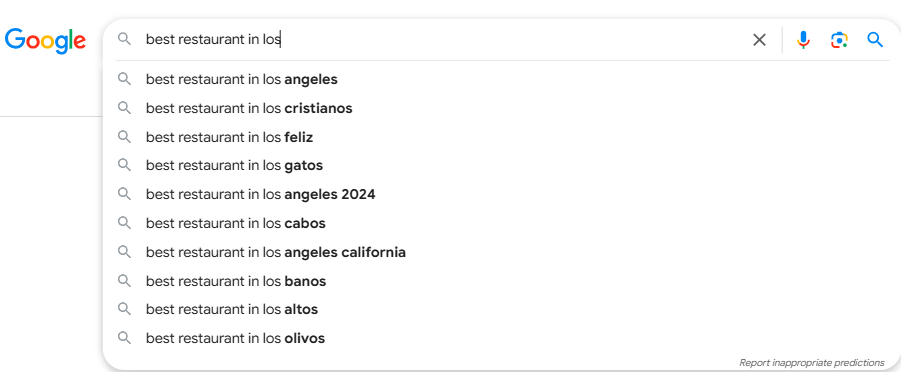Programmatic SEO is an automated approach to creating and optimizing large volumes of web pages tailored to specific long-tail keywords. By utilizing. This strategy enables websites to target niche audiences, improve organic visibility, and drive consistent traffic with minimal manual effort.
Take a travel website like TripAdvisor—it generates unique pages for every city, listing hotels, restaurants, and attractions. Similarly, Amazon creates programmatic pages for every product, variation, and category, targeting a vast range of search queries.
If your business operates across multiple locations, sells numerous products, or provides extensive services, programmatic SEO could be the game-changer that helps you dominate search rankings.
One of the biggest advantages of programmatic SEO is its ability to scale quickly. Instead of manually creating pages, businesses can generate thousands of keyword-targeted pages in a fraction of the time.
For example, Michellin Guide has millions of dynamically created pages for a series of variations in the restaurant business for multiple locations in the US region.



By targeting highly specific, low-competition long-tail keywords, programmatic SEO can significantly boost a website’s visibility.
Wise successfully used programmatic SEO to create unique pages for virtually every currency pair—such as “USD to EUR” or “GBP to INR”—catering to users searching for currency conversion rates. This strategy helped them attract over 4.6 million organic visits per month.
While setting up programmatic SEO requires an initial investment in automation tools and structured data, it significantly reduces long-term content production costs. Once implemented, businesses can maintain and update their content with minimal manual effort.
By automating content generation, programmatic SEO ensures a uniform page structure and enhances user experience. Tools like Jasper, Copy.ai, and Writesonic help generate AI-powered content, while plugins like WP Auto Content enable dynamic content updates.
Before jumping in, consider these factors:
While programmatic SEO is powerful, it’s not without risks:
Start by identifying broad keyword themes and modifiers. Tools like Ubersuggest and SEMrush can help you discover valuable long-tail keywords with low competition.
Example: Real Estate Platform
A real estate website can combine keywords like “homes for sale” with modifiers such as city names and property types:
Programmatic SEO relies on structured data, such as:
Example: A real estate website would need data from sources like public databases, APIs (e.g., Zillow API), or web scraping tools to populate dynamic content.
Create dynamic templates that automatically insert relevant data for each page. A restaurant directory, for instance, could use a template like:
This ensures consistency while allowing for thousands of unique, SEO-optimized pages.
Each page must provide real value, answering user queries with high-quality content.
A strong internal linking structure improves user navigation and distributes link equity effectively.
Example: A local business directory might implement:
Tracking performance is crucial for refining programmatic SEO strategies.
Example: An affiliate website tracking laptop comparison might:

Some research done around long tail variations for the term,” Top SEO companies in ____” led to the discovery of various listing & review websites ranking on the top 5 positions.

Websites like Clutch have published a series of pages for the phrases like “Top SEO companies in __Locations__MonthRankings__”

Zapier automated the creation of 800,000+ integration pages, driving 306,000 organic visits per month by targeting niche, long-tail queries.
A few examples of such pages are:

1. {App} Integrations pages – Zapier published a series of pages which focused on transactional intent keywords like “gmail integrations”, “google sheets integrations”, “google docs integrations” which collectively generated 100K+ organic traffic for Zapier.
2. How to connect {app1} + {app2} pages – In this case Zapier created a series of pages that were transactional in intent and focused on integrations features within applications like “how to connect google sheets + trello”, “how to connect google sheets + outlook”, and many more.

Wise built 31,500+ currency conversion pages, attracting 27,600 organic monthly visits, demonstrating the power of automation.
Programmatic SEO is a powerful tool for businesses looking to scale their organic search presence. By automating high-quality, intent-driven pages, companies can expand their reach, improve search visibility, and drive sustainable traffic.
However, success requires careful planning, structured data, and ongoing optimization. When executed well, programmatic SEO can be a game-changer for businesses ready to dominate their industry’s search rankings.
Everything you need to know about the product and billing.
Industries with extensive product catalogs, service variations, or location-based offerings—such as e-commerce, travel, directories, and SaaS platforms—see the most success.
Automated content must still meet Google’s Helpful Content guidelines. Ensure each page provides unique, valuable, and intent-driven information to avoid penalties.
Yes—poor implementation can lead to duplicate content, technical errors, and algorithmic penalties. Proper execution and continuous monitoring are essential.


Can’t find the answer you’re looking for? Let’s collaborate and unlock your Tru potential.
Share this blog